Search engine optimization advances at an unbelievable rate, which means the way you approach SEO and your content has to evolve too.
In fact, search engines and their algorithms have become increasingly more sophisticated at semantic analysis. Take Google’s Hummingbird update, for example – it gives the search engine the ability to understand the context of a search rather than just the string of keywords used.
Gone are the days of keyword stuffing – you need to have a comprehensive understanding of the topics you cover in order to demonstrate your authority to the end user (and gain visibility in this new age of search).
But the challenge is that it can be difficult to know what to include in a body of copy to make it relevant and authoritative – especially when a content writer is faced with a topic or industry that they are unfamiliar with.
So, how exactly do you succeed at SEO content creation? The answer lies with Content Fusion.
What is Content Fusion?
Content Fusion is an AI content optimizer that lets you create quality, authoritative content at scale. It allows you to optimize new content that is ready to launch, or you can use it to refresh old content.
Because Google’s method of determining relevancy and authority has shifted from basic keyword matching to a more holistic understanding of a topic as a whole, Content Fusion presents you with 20 must-use keywords to include in your content for your target keyword.
This allows you to tackle a subject from all angles, and demonstrate your understanding of the topic.
When we identify the right content opportunities, Content Fusion has consistently helped deliver page one rankings because our content is more comprehensive and more relevant to search and user intent.
— Chris Giovagnoni, Compassion International
Here’s an example:
Let's say we have a published piece that targets the keyword “maxi dresses” but it doesn’t rank too well on the SERP. Let’s run the target URL and keyword through Content Fusion.
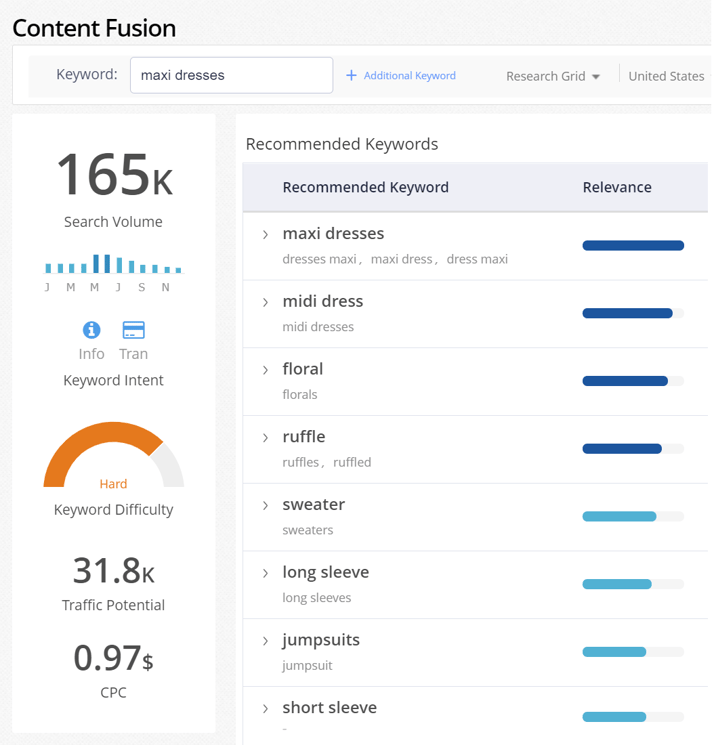
(Must-use topics for “maxi dresses” inside Content Fusion.)
Content Fusion uses it's own AI and proprietary algorithms to present us with the topics that are related to our target query of “maxi dresses". Users want more in-depth information now more than ever before, and this simple workflow allows you to do that, even if you’re a content writer not extensively familiar with the topic.
(Content Fusion runs a web-scale crawl, aggregates billions of SEO data points from a variety of sources, and presents you with 20 must-use keywords and their appropriate context.)
We want to update the content to include all of the terms to demonstrate our complete understanding of the topic, and signal to the search engine that this content is authoritative – which is exactly the kind of content a search engine like Google wants to present to the end user.
Plus, Content Fusion speaks multiple, languages so you can reach a number of audiences all over the world, and it offers interlink recommendations to strengthen your topic authority.
So what exactly does this mean for your rankings? Let’s take a look at how this quick workflow has led to big results for a variety of industries.
Recommended Reading: A Lightning-Fast Guide to the AI Content Marketing Workflow
Content Fusion Success Stories
Simple tweaks to your content can bring great results for overall traffic for that given page. Below are a few examples of how companies used Content Fusion to boost their search visibility.
These success stories not only showcase the power of AI, but prove the value of what we’ve learned from the advancements of search algorithms – that semantically related keywords are the future of content.
Note: SEO isn’t just about keywords. It’s also important to have proper site usability and an established topic cluster to become a quality and authoritative source.
Making.com
Production technology platform Making.com used Content Fusion to conduct content research and analysis. Their site contained a lot of published pages, but their SEO Specialist noticed that the content on these pages were not serving the intent that the SERPS and users were looking for.
The SEO specialist used Content Fusion to provide their in-house content team with the analyses and suggestions from Content Fusion to improve their existing content.
They also saved time in content research for new pages and noticed words and phrases to include in their content that they otherwise would not have included. They noticed a significant difference in the analysis provided in Content Fusion compared to other solutions they had used in the past.
As a result, the SEO Specialist noticed an improvement across the Making.com site rankings right away. Over the span of one month, the team saw an 89% increase in the number of terms ranking in the top 3 as well as a 37% increase in the number of terms ranking in the top 10.
Humanitarian Organization
Just within the Content Fusion trial, the content team at a humanitarian organization was able to improve one target keyword’s ranking from a position above 50 to position 3 – within a month.
And their success didn’t stop there. This team was also able to move a keyword from outside the top 100 results to the first page of the SERP within a matter of weeks.
Industrial Supply Company
This industrial supply company sells a lot of commercial products, yet they weren’t ranking for the general non-branded name of a specific product that they sell. They weren’t even ranking in the top 100 on Google.
Needless to say, this is not good for a.) site visibility and b.) conversions on the site for that product.
This company was one of the original beta testers of Content Fusion, and after loading the must-use keywords into their existing category copy, they saw a huge increase in rank. Specifically, they began to rank on page two of the SERP – all in three days time.
seoClarity
Of course, our content team uses Content Fusion to optimize our copy too! We categorize our pages that have received a Content Fusion update in a tag, which makes it easy to track and report success. This will be especially useful to enterprise organizations – you want to see the aggregate success of your hundreds, thousands, or millions of pages.
Here’s an overview look at seoClarity’s steady success over a nine-month period.
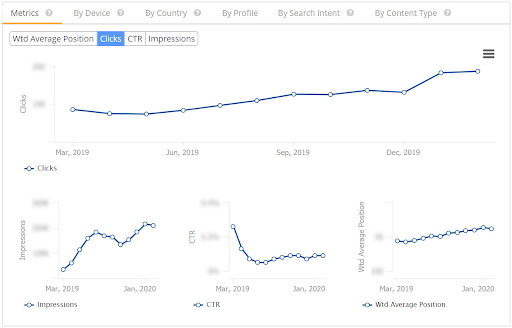
(Aggregate view of seoClarity's updated content.)
Let’s take a more detailed look at an individual page. We noticed that one of our blog posts was not performing as well as it had in the previous year.
This YoY analysis let us know that something had to be done, so we ran the URL through Content Fusion and added in any missing must-use keywords (and made sure the article was supported by its relevant topic cluster).
We’ll let the data speak for itself:

(Google Analytics YoY trend for one page.)
Before we knew it, we beat the previous year’s numbers – something that had only really happened once before in the given time period.
Another YoY analysis that shows Content Fusion's impact over time is of our beginner to intermediate level content group.
 (Year-over-Year analysis for a specific content type.)
(Year-over-Year analysis for a specific content type.)
This specific content type only saw two net new posts — all other changes to the content were updates, optimizations, and internal links optimizations based on Content Fusion recommendations.
You don't have to wait months or a full year to see concrete results in traffic and impressions. Let’s look at some more data.
We noticed that we had a blog post that received nearly nothing in impressions. A Content Fusion update on January 21, 2020 brought in a surge of impressions the next day.

(Content Fusion updates led to an increase in impressions almost instantly.)
Travel Booking Agency (1)
For this online travel agency, we conducted a test on a collection of pages over a three-month period. The test group used Content Fusion to optimize content, while the control group continued to use their normal operating procedures. Here are the results:
The test group (i.e. Content Fusion users) saw a 12% increase in weighted average rank for the group of pages. The control group (i.e. no Content Fusion) saw a negative 1% decrease in the weighted average rank for those pages.
In the chart below, the red line indicates their normal optimization process, while the orange line represents Content Fusion updates, and the green line is the aggregate.
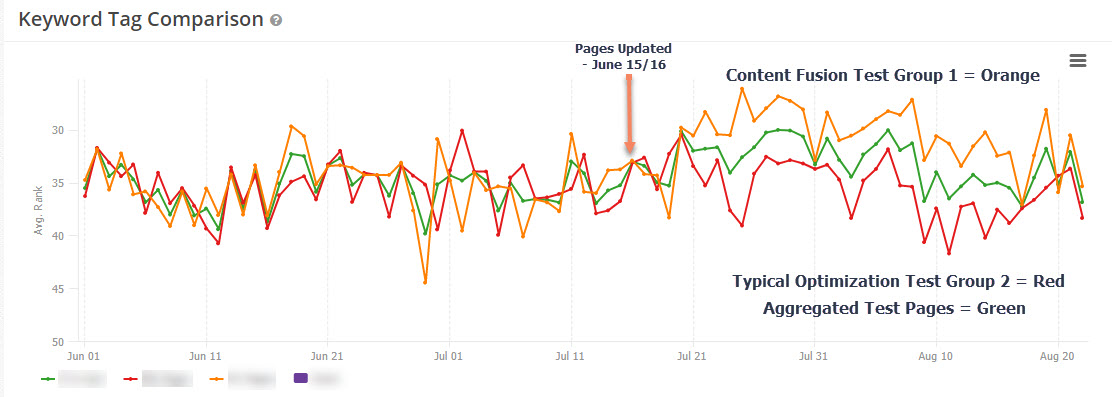
(Content Fusion updates compared to the normal optimization process and aggregate test pages.)
Travel Booking Agency (2)
A second online travel agency used Content Fusion to properly optimize their content too. The workflow revealed a very important keyword was missing from the content that was centered around a specific hotel location.
The SEOs did not know what the keyword was or how the keyword related to the hotel property, but after Content Fusion revealed the opportunity, the SEOs did some research.
It turns out that the keyword was the name of a popular buffet restaurant within the hotel. The subsequent inclusion of this keyword into the content improved the long-tail by 20%.
Drizly
Alcohol delivery service Drizly used Content Fusion to optimize their local pages. Their local pages with custom content — resulting from Content Fusion insights — historically rank at least one rank position higher than local pages without custom content.
An arguably larger success, however, is how Content Fusion has been used to bridge the gap between SEO and other departments. Content Fusion allows other teams to see why it's important to include keywords, why putting titles in the form of a question helps to optimize a page, and it shows the team questions that they should consider answering to be able to rank for additional keywords.
Jewelry Retailer
Through seoClarity’s Managed Services, this jewelry retailer’s digital team worked to build out a dashboard illustrating weighted average rank following their site migration. Additionally, keywords were monitored based on specific merchandising categories for the organization’s various product teams.
For topics with opportunity to recover or grow visibility, content was added and the weighted average rank was monitored over a 15-week period. This metric was compared against a control of all category pages through the same time period.
The SEO content strategist was able to monitor at each of the time-based intervals where content was not performing as expected and where adjustments were required by the content team. Where ranking declines occurred, the team performed Content Fusion’s content decay workflow.
What were the results?
Once use of content dashboards and structured workflows were implemented, the jewelry retailer was able to identify overall traffic-boosting impact of creating new content as well as improving already existing content.
New content was added to eCommerce category pages and the brand out-performed the control group by 6% over a 15-week period. The team also identified an incremental increase in organic visits over a 4-month period, and increased their traffic driving keywords.
Conclusion
As you’ve seen, AI content marketing has great potential to increase site visibility, and with Content Fusion you can create authoritative content like never before. But of course, these content updates work well if you have other things in place, like proper site usability and an established topic cluster for your content.
seoClarity’s platform allows you to organize content and keywords into tags, which makes it easy to keep track of your Content Fusion updates and successes over time.
Curious to see how you can stop the content chaos and optimize copy at scale? Try our two week free trial of Content Fusion to bring success to your organization.





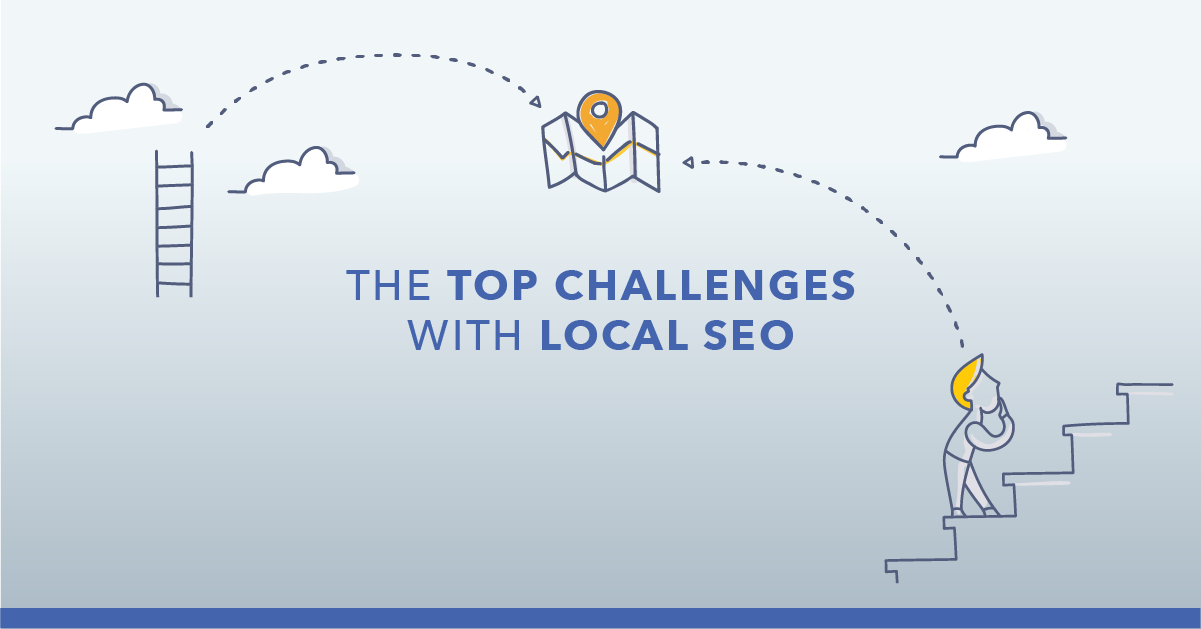
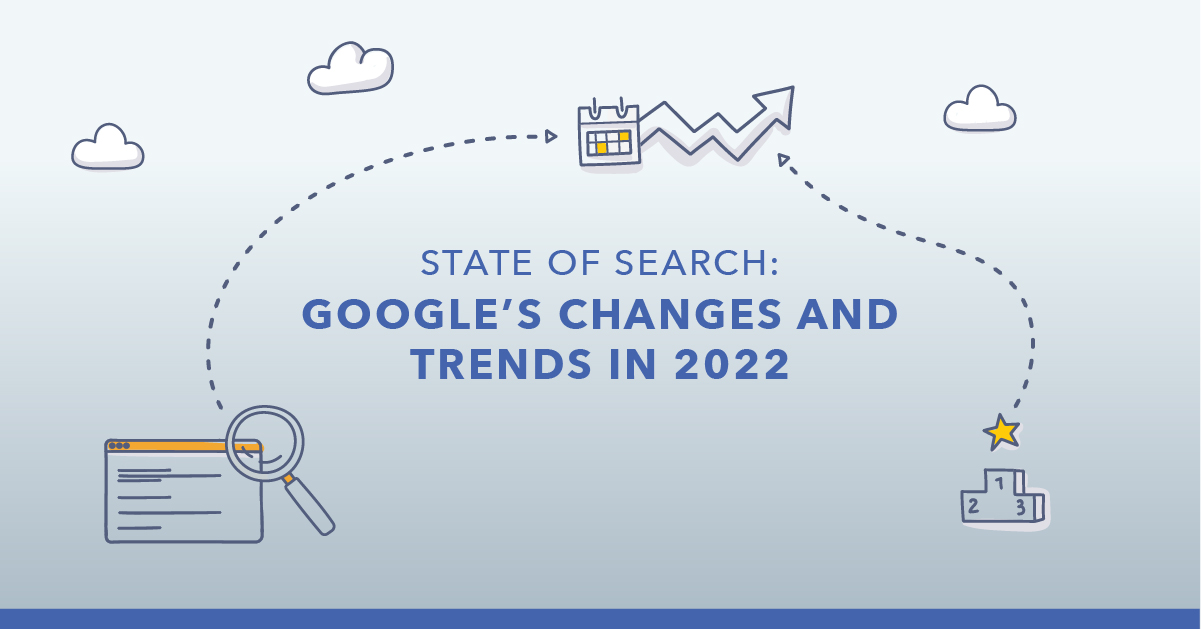

1 Comment
Click here to read/write comments